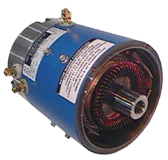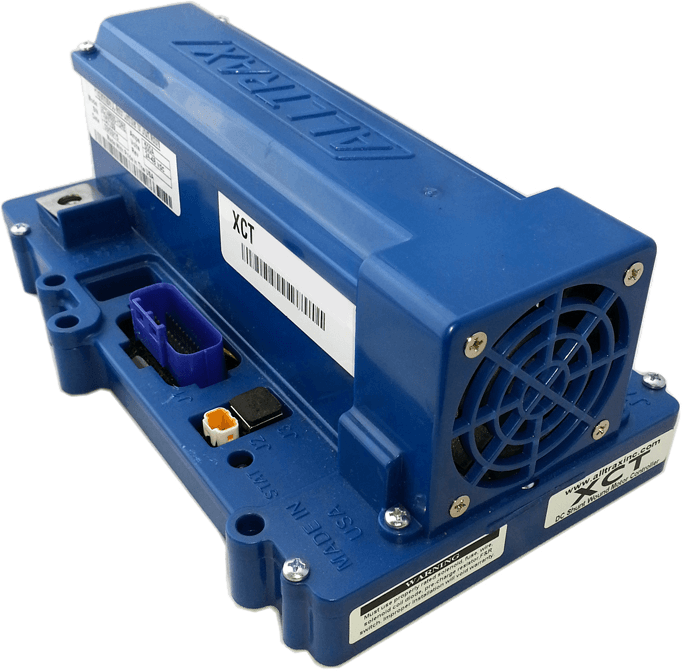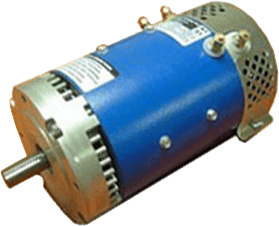Browse
Dealer

High Performance DC Motors and Controllers
Buy a Golf Motor/Controller
Golf Cart Motors & Parts

Golf Cart Controllers

All other DC Motors

Made in the USA
The only DC Motors Manufacturer in America
Fast, Reliable Shipping
We provide fast 2-3 day shipping in the USA
Engineering Expertise
Unparallel customer support from our expert engineers
Give us a call with your vehicle specifications and requirements. We can design a custom dc motor to suite your needs. Our current design capabilities are: 1 to 10 HP (horse power) continuous duty rating - up to 25 HP (18.5 kW) Peak, Frame O. D. - 6.69 inch, Voltage - 12 volts, 24 volts, 36 volts, 48 volts up to 72 volts (higher if required). Complete range of wound field construction (series or separately excited). Meets all Class H temperature ratings. Experienced in the material handling, utility vehicle, NEV, aerial lift, airport support vehicle, golf cart and several other electric vehicle markets.
We now have a full range of heavy duty programmable series & regen controllers for most electric golf carts and many other electric vehicles. We also have non-programmable golf cart controllers as an economical alternative. Upgrade your golf cart controller to get more torque out of any vehicle. We offer 12 volt, 36 volt, 48 volt and 72 volt golf cart controllers, with current outputs of 300 amp, 400 amp, 500 amp & 650 amp for series vehicles, 300 amp, 400 amp & 600 amp for separately excited vehicles. Our golf car controllers cover almost any series golf cart controller upgrade and many regenerative braking applications (EZ-GO - DCS & PDS controllers & Club Car - IQ & Precedent, PD Plus & Yamaha G-19 controllers). We are currently expanding our regen golf car controller product line to include Yamaha: G22 models. We have E-Z-GO controllers, Club Car controllers, Yamaha controllers. Upgrade your golf cart speed controller today!
Look here for new product releases. D&D Motors Systems is currently the only electric motor manufacturer with True Regen High Speed and High Torque replacement motors and motor / controller combos for E-Z-GO: DCS & PDS vehicles.
Get more performance out of your NEV's. D&D Motor Systems is the premier US made neighborhood electric vehicle motor manufacturer. We make many replacement NEV motors that include the Ford think motor, GEM motor, pathway motors, Dynasty motor, E-ride motor, along with many more. Our ford think motor has had years of flawless field time in the ford think golf cart. In addition, our 7.5 HP GEM motor is well known for its excellent performance in the gem electric car market over the last 10 plus years. Click here for more details. Always ask for the BLUE motor!
D&D Motor Systems, Inc. warrants each of its dc motors and controllers to be free of defects related to workmanship or material. DC Motors are warranted for a period of one-year and controllers are warranted for a period of two-years, both from their respective D&D Motor System ship dates.
If the motor and/or controller has received normal use and service. Each motor and/or controller returned must be accompanied with a description of the problem, the part number and the serial number. For complete warranty information, click the link above.
If you would like to see our entire selection of electric golf cart motors, this chart gives the basic performance characteristics of most of our motors, on one simple page. We have High performance electric motors. E-Z-GO motors, Club Car motors, Yamaha motors, Melex motors for most golf cart applications. We also have replacement motors with the same performance characteristics as the stock motor. See how the golf cart motor you have, compares to any of our heavy duty electric golf cart motors.
We offer the widest range of DC Motors and Controllers in the World for the Golf Cart Market. With so many different available combinations, this tool will help assure that you get the correct dc motor, controller or combination for your application. Looking for a High Speed motor or High Torque motor? We have High Speed motor and High Torque motor options for E-Z-GO, Club Car, Yamaha, Melex and most other vehicles. This guide will lead you to the dc motor and/or controller that will meet your heavy duty performance needs. Match you current D&D Club Car electric motor with a high performance electric motor controller. Look for the best series controller to go with your EZ-GO electric motor. Upgrade your Yamaha controller and/or motor for a high performance golf cart conversion. The electric motor and controller combinations for series and regen golf carts are endless.
D&D Motor Systems is the premier DC motor manufacturer in the U.S. for small to medium light-weight electric vehicle (EV) conversions. In addition we offer a complete line of U.S. made speed controllers to go with our high performance EV motors. Kick the oil habit now. It's a lot more practical than you think. This isn't a dream of the future. With a little effort, electric vehicles (EVs) are here today! At a cost you can afford! Save money now. Build your own Electric Car conversion.
This section helps our customers educate themselves in the area of using our electric dc motors and controllers. Within this section you will find technical information about: Sepearately Excited dc motors, Series dc motor, 48 volt golf cart motors, 36 volt golf car motors, hi torque E-Z-GO motor, hi speed Club Car motor, Sepex motors, Regen motors, dc motors, electric vehicle conversions, lifted golf cart motors, golf cart 4wd conversions, heavy duty golf cart motor installations, heavy duty golf car controller upgrades, golf car speed controller installation, anything to do with dc electric motors. You'll also find information on: high performance electric motor upgrades, high performance golf cart conversions, getting more speed from your golf car motor, getting more torque from your golf car controller. This is intended to be a useful guide for all things related to: High Speed electric motors, High Torque electric motors and electric motor controllers, golf cart controller, golf cart speed control, golf cart speed controller
Here you will find links to many golf car related products. We have links to golf cart parts. If you are looking for a golf cart lift kit, golf cart battery chargers, golf car batteries and golf cart accessories. Find the Club Car accessories, E-Z-GO accessories or Yamaha golf cart accessories for your high performance golf cart. Are you looking for electric car conversion products? We have links to sites which provide information and parts for electric vehicle coversions. We have links to golf carts parts such as: tires, F&R switches (forward and reverse switches), golf cart axles and golf cart enclosures. Links to electric motor golf carts. We have links to suppiers of golf cart controller accessories such as F&R switches and many other golf cart parts
We also sell rebuilt golf car motors and controllers as they become available. The motors come with our standard 1 year warranty (same as a new dc motor). The performance is identical to a new dc motor. The only difference is the price! Please call and check availability, our inventory on these rebuilt dc motors is limited. Experienced in the material handling, utility vehicle, NEV, aerial lift, airport support vehicle, golf cart and several other electric vehicle markets. We do not rebuild GE dc motors or Advanced Motors & Drives (Advanced DC Motors) dc motors. We often carry an inventory of used golf cart motors. Used golf car motors such as: club car motor, ez-go golf cart motor. Our used golf cart motors come with a factory warranty and perform the same as a new motor.